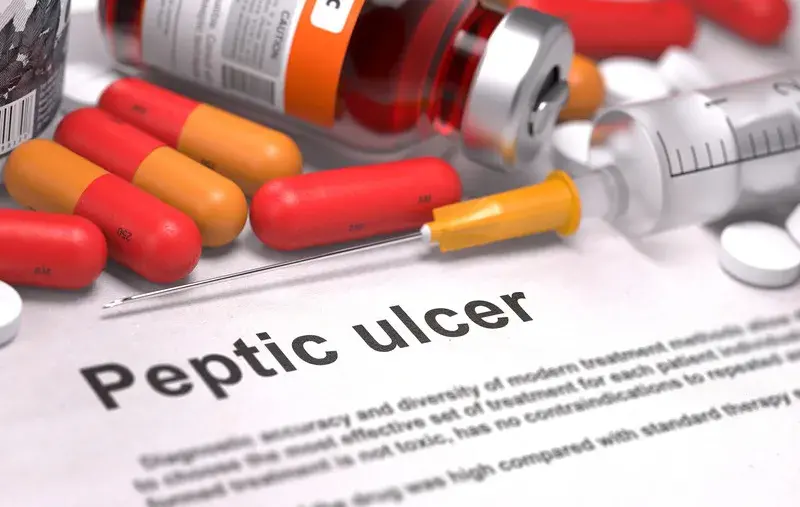A common health problem, a peptic ulcer is an open sore that forms when your stomach acids etch away the digestive tract’s protective layer of mucus. This condition usually occurs due to inflammation caused by the bacteria H. pylori, as well as from erosion by stomach acids. According to MedicalNewsToday.com, up to 10 percent of adults are affected by peptic ulcers at least once in their lifetime. Around 500,000 people develop a peptic ulcer each year in the United States (2017 statistics).
Typically, peptic ulcers develop inside the lining of the stomach, duodenum, or lower part of the esophagus and the upper portion of your small intestine. A dull or burning pain in the stomach is one of the most common symptoms of this condition, which may occur anywhere from the belly button to the breastbone. Peptic ulcer is a chronic gastric condition that presents different phases of symptoms, which can range from mild to severe. Documentation is critical to ensure appropriate care and accurate reimbursement, and medical coding outsourcing is an ideal option for physicians to streamline their documentation requirements.
Identifying the Causes and Symptoms of Peptic Ulcer
Infection with the bacterium Helicobacter pylori (H. pylori) is one of the common causes of peptic ulcers. Long-term use of aspirin and certain painkillers such as ibuprofen (Advil, Motrin, others), naproxen sodium (Aleve, Anaprox); habits like smoking and alcohol consumption; radiation therapy and stomach cancer can also contribute to this condition.
Generally, small peptic ulcers may not produce any symptoms in the early phases. As mentioned above, the most common symptom is a burning abdominal pain that extends from the navel to the chest. The pain symptoms can range from mild to severe and can be brief or may last for hours. It can become worse when the stomach is empty or right after eating (depending on where it is located) and sometimes become intense during sleep. Some of the other related symptoms include –
- Feeling of fullness, bloating or belching
- Nausea and vomiting
- Heartburn
- Fatty food intolerance
- Changes in appetite
- Bloody or dark stools
- Unexplained weight loss
- Trouble breathing
- Indigestion
- Difficulty swallowing food
- Chest pain
Stress and spicy foods do not cause ulcers. However, these can make your symptoms more severe.
Diagnosing and Documenting Peptic Ulcer
Diagnosis of peptic ulcer may initially begin with a detailed evaluation of patient medical history and physical examination. Patients may need to undergo several diagnostic tests such as –
- Laboratory tests for H. pylori – to determine whether the bacterium H. pylori is present in the body
- Upper gastrointestinal (GI) X-ray series – A series of X-rays of the upper digestive system is taken to create images of the esophagus, stomach and small intestine. During the procedure, patients need to swallow a thick, white liquid called barium (barium swallow) that coats their digestive tract and makes an ulcer more visible.
- Upper endoscopy – A long hollow tube, with a lens (endoscope) is passed down the throat and into your esophagus, stomach and small intestine to examine the area for ulcers.
Treatment for this gastric problem will mainly depend on the specific type of ulcer and its underlying causes. Treatment methods may generally focus on killing H. pylori bacterium, (if present). Gastroenterologists may prescribe a combination of medications including –
- Antibiotics like – Amoxicillin (Amoxil), Metronidazole (Flagyl), Tinidazole (Tindamax) and Tetracycline (Tetracycline HCL)
- Proton pump inhibitors (PPIs) like – Omeprazole (Prilosec), Lansoprazole (Prevacid), Esomeprazole (Nexium) and Pantoprazole (Protonix)
- Acid (H-2) blockers like – Ranitidine (Zantac), Famotidine (Pepcid), Cimetidine (Tagamet HB).
Antacids and other prescription medications like sucralfate (Carafate) and misoprostol (Cytotec) may also be prescribed to neutralize stomach acid and protect the lining of your stomach and small intestine.
ICD-10 Codes to Use
Gastroenterologists are reimbursed for the treatments provided to their patients. The diagnosis and other tests offered must be reported on the medical claims using the correct medical codes. Medical billing and coding services provided by reliable companies can help physicians use the correct codes for their medical billing.
Gastroenterology medical coding involves the use of specific ICD-10 codes to document several conditions, including peptic ulcers. The following ICD-10 codes are used to indicate a diagnosis of peptic ulcer for reimbursement purposes –
K27 – Peptic ulcer, site unspecified
- K27.0 – Acute peptic ulcer, site unspecified, with hemorrhage
- K27.1 – Acute peptic ulcer, site unspecified, with perforation
- K27.2 – Acute peptic ulcer, site unspecified, with both hemorrhage and perforation
- K27.3 – Acute peptic ulcer, site unspecified, without hemorrhage or perforation
- K27.4 – Chronic or unspecified peptic ulcer, site unspecified, with hemorrhage
- K27.5 – Chronic or unspecified peptic ulcer, site unspecified, with perforation
- K27.6 – Chronic or unspecified peptic ulcer, site unspecified, with both hemorrhage and perforation
- K27.7 – Chronic peptic ulcer, site unspecified, without hemorrhage or perforation
- K27.9 – Peptic ulcer, site unspecified, unspecified as acute or chronic, without hemorrhage or perforation
Peptic ulcers, if left untreated can become worse over time and lead to several serious health complications such as internal bleeding, scar tissue and perforation. With proper treatment and consumption of medications, most cases of peptic ulcers heal. In addition, incorporating healthy lifestyle choices such as – quitting smoking and other tobacco use, limiting the frequent use of anti-inflammatory drugs (like ibuprofen, aspirin, and naproxen), and eating a balanced diet will help you prevent developing peptic ulcer in the long run.




